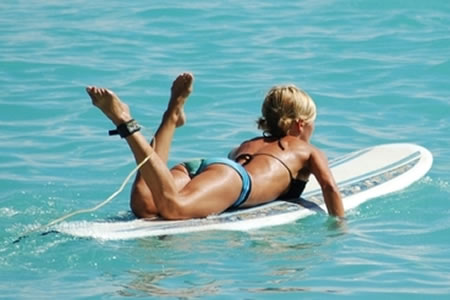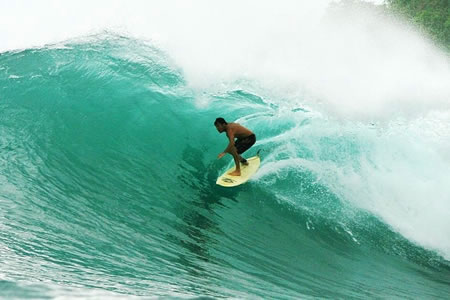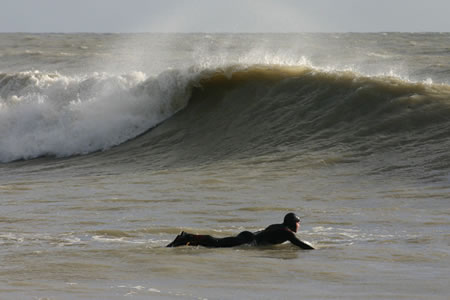
A short history lesson today guys. Surfing can be dated back to before Captain Cook’s discovery of the ancient Hawaiian kings riding on the crest of a wave back in the eighteenth century and yes much has changed in the sport since then. Through out the past 300 years, one thing that remains the same is the uncontrollable, throw your hands in the air and scream to the gods feeling you get when you stand up on your first wave.

How you explain it I'm not sure, and even if I did it wouldn't do it justice. Picking the right wave, paddling like a madman or woman, feeling the wave begin to propel you forward and take control and then you pop to your feet. For a split second you think you’re in control but then you realise the ocean is fighting to throw you in the dunk. Experiencing it firsthand is the only way you can really understand what I’m talking about so get some gear and get wet.
Wetsuit – If you’re planning on surfing in the UK during the summer or winter then a wetsuit is going to be needed to maintain any sense of feeling in your extremities. Get down your local watersports retailer and get the guys in the know to fit you up as the correct sizing of a wettie is crucial to its function. If you already know what make and sizing you want then use one of our featured online stores to get yourself kitted out and pick up some hot deals.
Leash – A leash or leg rope is basically a long lead that attaches from your ankle to the back of the board to prevent you from being separated. They are at least as long as the length of the board so that if you wipeout it’ll be out of the way by the time you surface but close enough for you to hope back on quickly before the next wave comes.

Wax - An integral piece of equipment if you’re planning on staying on the board for any length of time. You can pick up bars of wax in any surf shop and they come in various shapes, colours and FLAVOURS depending on the water temperature you are surfing in. If you’re surfing in the UK then look for cool or cold water wax as this will give you the most traction. You rub the bar on the TOPSIDE of the board, in true Point Break style to improve grip. Beginners - It is a myth that wax is put on the underside of the board to make it go faster. You just rub it on the deck, otherwise you’ll probably look like a weiner at the beach.
Board - There are 3 main types of board to choose from when surfing. Only 2 of these are really suitable for the beginner. Foam, boards which are generally blue and yellow are the most forgiving surfboard to start on and can be rented at most surf beaches. Although they are the most forgiving, they also have limited suitability for the improving beginner due to their very basic design .They will however be a perfect platform for the standing up stage of the learning process but I would advise you only to rent these boards.
A pop-out board is the most suited to beginners who wish to buy their first board. These are made from a mould which is filled with liquid plastic in a factory so that mass production of these can be made. They come in various shapes and sizes and it is important not to just but the board which you believe will look the best under your arm. Take advise from people who work in the industry and in surf shops to make your choice. A board for a average height beginner would be between 8ft and 9ft.. This size would have plenty of volume to enable you to catch waves easily and therefore have a much better time out surfing. A board that is smaller with less volume will be harder to paddle and therefore less waves will be caught, you’ll get frustrated and probably chuck it all in on the first day! Remember -Take our time on choosing the correct board and get as much advice as possible.
One of the keys to good surfing is learning how to correctly paddle the surfboard. A good paddler catches plenty of waves while poor paddlers spend most of their time and energy missing them. So, here are a few tips on how to get the most out of your surfing by developing your paddling skills.
The beginner frequently has difficulty paddling because of poor body positioning on the board. If you are too far back on the board it will tilt up in the front and you will be pushing water, this will slow you down. If you are too far forward on your surfboard then the nose will sink or pearl, another bummer. Remember, your surfboard is balanced correctly and under control when the nose is one or two inches out of the water. The flatter the board is on the surface of the water the better it will glide.

Try to feel comfortable on your board, be centered and look closely at the tip as you begin paddling. If you pay close attention to how well the board is moving through the water you will see right away if you need to reposition your body in order to improve your glide.
Paddle one arm at a time. Stretch the arm outright, fingertips pointed and together and have the hand enter the water smoothly. Bring the arm down and through, making sure to complete the stroke at the finish. Keep your eyes focused towards the tip of your board to make sure that the surfboard is flat on the water and that you are pointed straight in toward the beach. This will help you get the right angle into the wave.
When you are paddling out to get to the surf, take your time and don’t rush. Depending on where you are surfing, the first paddle out from shore can be difficult and you can get tired quickly. You may have to paddle a long way or for a long time, so take it easy, don't burn out. The difficulty in paddling out is more due to the prevailing surf conditions and how well you deal with the oncoming surf, than it is how fast you can paddle.
When you try to paddle in to the whitewater wave, or if you have advanced to the outside, you must sprint to catch the wave. Eight or nine of the hardest deepest strokes that you can summon up. You must bring the surfboard up to speed as the oncoming wave rushes up from behind, while remaining perpendicular to the wave
The whitewater, is where beginners starts their surfing experience. You want to spend enough time in the whitewater to learn how to pop up on your board and land in the sweet spot so you can ride. The whitewater wave pushes the board across the flat water. This gives beginners as much time as is necessary to get up on their feet. This is a good thing at first. Later on, after figuring out the landing in the whitewater, you can try the more exciting green wave on the outside. The green wave is far more challenging because of its slope, and should only be attempted after meeting success in the whitewater.
When catching and riding whitewater waves, try to be selective. You want a wave that has enough power to move you along for a good distance. Choose waves that look organized and are moving straight in toward the beach. Many whitewater waves come in from odd angles and have more of a confused look, or are in the process of overtaking the wave in front of them. When the surf is messy it is hard to pick a wave which will be suitable to ride.

Walk out holding on to your surfboard near the nose, with most of the board training behind you. The less board that sticks out in front of you the better. Try to always keep your board pointed straight out as you head out, or straight in as you get ready to go on the wave. Avoid letting your surfboard swing around sideways or the next onrushing wave may return your board into you in an unfriendly manner. Whenever possible, lift your board higher than the oncoming wave as you walk out or you will be losing more ground as you go. Walk out just past your waist and then see if you have enough time to turn your board around. If so, lift your board in the middle using two hands and point it straight toward the beach.
The only three things that matter in catching the whitewater are... the board and the wave must be perpendicular to one another, the body must be centered properly on the board, and the board must be already moving into the beach when the wave hits you. So, as your wave approaches you, line up the board so it is pointed straight towards the beach, and when the wave is about 10 yards away, jump onto your board and begin to paddle. As you go you must keep your board perpendicular and flat. Too much angle to the beach will cause the board to flip over. You must also have your body centered correctly. If the wave hits you and you are too far forward on your surfboard, you will pearl or nosedive. Too far back on the board and you won't catch the wave. Now that you are perpendicular and centered, its time to start paddling.
You will need 7 or 8 strokes to get up enough speed to catch the wave. As the whitewater wave rushes onto the back of the board, stop paddling and hold on tight to the rails at chest level. As the wave hits you hold tight. You will then feel the wave pick you up and propel you in front of it. Now is when you want to pop up, landing in the middle of the board.
Timing and wave judgement are crucial and your success rate will increase as your timing improves. Most beginners will spend anywhere from three to five days learning the hop-up and figuring out how to balance on the board in the whitewater before they are ready to attempt paddling out and riding the unbroken waves.
Keeping your surfboard flat underneath you while you surf can only be accomplished after you understand how to keep your weight centered in the middle of the board. Here are a few tips on how to get it done.
When you surf, you must stand sideways on the surfboard. With either the right foot near the back, which is called "regularfoot", or with the left foot towards the back, which is called "goofyfoot". Neither way is better than the other, but you will be better one way or the other. If you skateboard or snowboard you should surf the same way. It is the upper part of your body that needs to be most centered. It is critical to keep your hips centered over your feet and legs shoulder width apart. Then you can use weight shifts by applying more weight to one foot or the other to keep the board flat. The flatter the board stays the farther you will go on the wave.

When you land on the surfboard your front foot should be near the center and your back foot about 18 inches to two feet from the back. The wider apart you can spread them the better, as you will need a wide low stable stance in order to rise up and be in control of the board.
POP UP - When coming up to your feet after catching a wave you will need to grab your board at the rail. It is very important that you reach back to the middle of your chest, right at the bottom of your ribcage, just like when doing a push-up. If you do not grab the surfboard here you will have poor leverage and the pop-up will not be your friend. First, bring the shoulders up until the elbows lock, while leaving your knees on the back of the board. Now summon all of your strength, and using your stomach and leg muscles kick your hips up as high as they will go. Now bring your feet off the back of the surfboard and bring them underneath you and land in the middle of the board.
Both feet leave the board at the same time and both feet land back down at the same time. Be careful not to bring the back foot up too far or your stance will be too narrow. Once you begin to land in the middle the surfboard, it will remain flat so you can release your hands from the rails and rise. As you come up into the stance, continue looking at your surfboard as you may need to start shifting your weight right away. Now you are up and flying to the beach with the greatest of ease... surfing !!
Practice this technique in the shallows in the whitewater until you can come up and surf at least half of the time. Then you will be ready to paddle out and do the really cool wipeouts on the twenty footers outside.
So, you are now ready to paddle out and attempt the unbroken surf on the outside. The question is how do I get through all of that energy and surf to get out there in the first place.
Once the surf reaches the head high to a few feet overhead zone paddling out will be an issue unless you are surfing a spot with a good channel or you are surfing a point where you can paddle out around the energy instead of through it. If not, strap on your paddling muscles and listen up cause its not about how fast you can paddle as much as how well you deal with the oncoming surf.
When paddling out we must consider the whitewater the enemy. Whenever possible you will want to lift up and go over the soup or dive down to go under the white stuff. The bad news is that because you are a beginner you must be on a bigger board in order to surf and bigger boards don't dive under well. So, you are going to be stuck on the surface where all of the energy is.

When encountering an onrushing whitewater wave, try to go straight into it. As perpendicular as possible, the more off angle the wave hits you the more ground you will lose. If you are able to not lose all of your momentum, you will be able to get going again right away. If you do get hit hard and spin out you will be starting off from scratch again and you will be making very little progress. Once again its not how fast you can paddle, its how well you deal with the onrushing and powerful bands of energy coming at you.
Walk out as far as possible, jumping over the waves while holding on tight to your board. Once you are out to chest deep wait for a calm period, or a lull before you start your paddle out. Be certain to position your body properly and begin stroking out. Until you encounter the bigger waves stay prone on your board and when you come to a small whitewater wave simply lift your upper body up by grabbing the rails of your surfboard at the ribcage and lift your head and shoulders above the white stuff. As your body lifts above the energy you will be sending your board underneath the energy. This method works just fine until you can no longer go over them anymore.
Bigger waves will also be more powerful and all of that energy is up on the surface where you are so you have to go under to get out. How far down you can go depends on how much foam you are on and how strong you are. But here is the trick, just before the wave is going to slam you, you must pull yourself forward to the front of the board, grab the nose tightly with both hands and send the nose down as deep as you can. At the same time wrap your legs around the middle of the board and hang on tight, expect to be dragged under water for a couple of seconds.
When you surface scoot back into paddling position and get moving unless more waves are going to break in front of you. If they are the best thing to do is to get off of your surfboard and hold on to the nose while the set does its thing. By getting off of your board you will not lose as much ground and you will be better rested for your next assault through the raging surf.
If you find that the waves are more powerful than you thought and you are not in total control of your surfboard then you should not try to go all of the way out! Stay inside and work on your skills and get stronger for the next swell.
It will take years of practice before you will be able to paddle out and surf BIG waves anyway but by improving your paddling skills your surfing will be far more enjoyable and worthwhile.
Now that its time to venture outside to ride the swells, you're gonna need to know how to behave and fit in, so as not to cause a problem once you finally do make it outside.
Learning how to be safe out in the surf will insure you years of enjoyment and keep you free of hassles from the other surfers in the water. In order to not get into the other surfers way, it will help you to understand the rules of the road, so to speak. The main issue here is safety. Fiberglass surfboards that are traveling along at a good clip can be potentially dangerous if they come in contact with another rider or yourself. In other words, when they hit you they really, really hurt. So listen up gremmie.
Good surfing waves have a peak, somewhere in the middle of the wave usually. This is the part of the wave that will break first and is the steepest part of the forming swell. The paddler closest to this peak will have the best chance of catching the wave first and will be awarded the wave by the other interested surfers in the area. Because we always surf away from the peak and the whitewater, where the peak is will dictate which way we must go on the wave.

If another surfer is paddling for the wave and is closer to the peak, its their wave. Because the other surfer has superior position on the wave, they will catch the wave first, go flying down to the bottom and come screaming down the line as you drop in on him and he runs you over, its your fault. So do not "drop in" on people. It shows poor form and is potentially very dangerous. It can also seem to be a show of disrespect to another individual. This can create a problem.
As long as you adhere to this one simple law you will never be in the wrong. After you have surfed for sometime you will realize, as I have, that there are always exceptions to any rule or law. But for now... if in doubt, give the other surfer the wave. Don’t learn the hard way. Be careful, and err to the cautious until you have had your feet wet for sometime and can make the call and the drop.
Do not surf in a big crowd or you are inviting trouble for yourself. Look, beginners do not need the best shaped, perfect wave anyway. At least not until they can appreciate it. The problem is this ... all of the great surf spots are not a secret anymore and they are already overtaxed by surfers that have bonded with these places. If you go out there and start making mistakes and you are a kook, it can get ugly. Its a big ocean, so let's use the part that isn’t already overcrowded. The other breaks down the beach away from the shredders will be just fine and you can still enjoy the pure joy of surfing with just your friends, or even all by yourself.